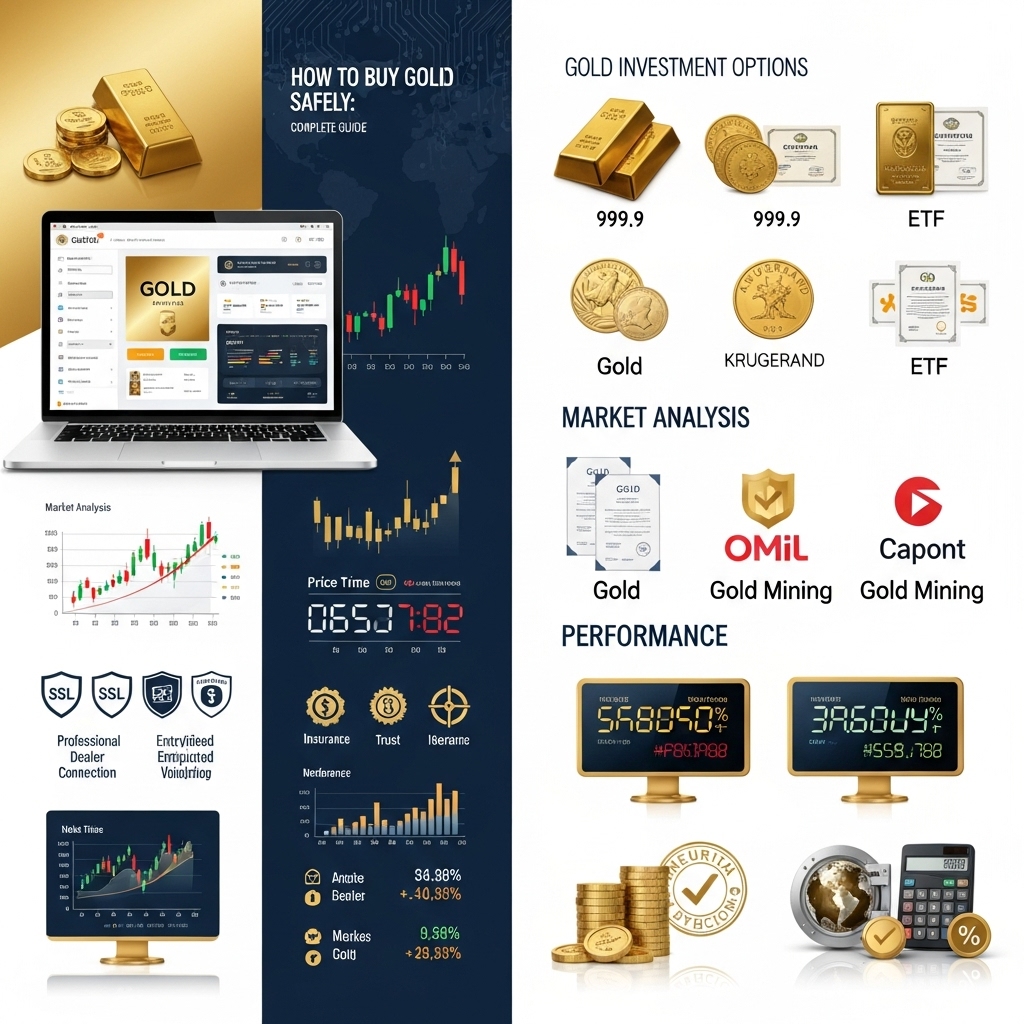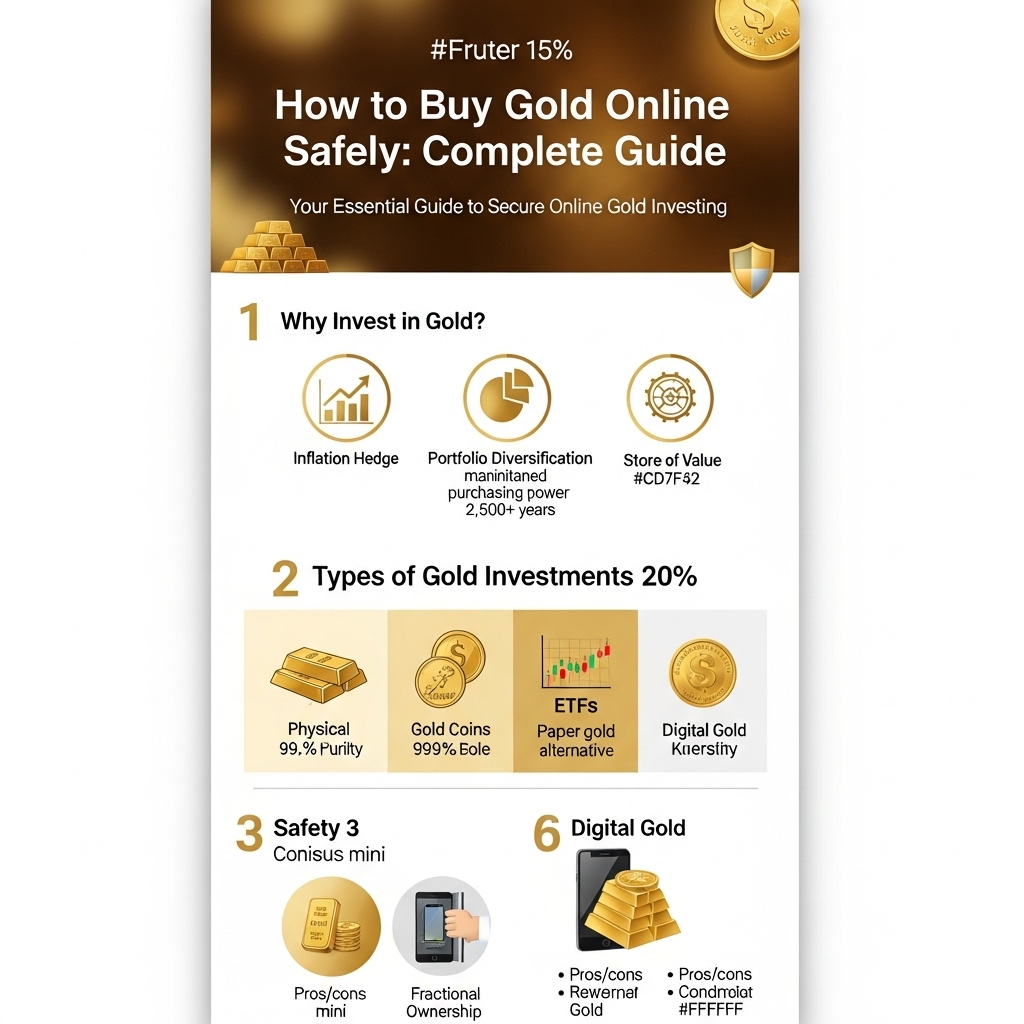The Smart Investor’s Guide to Secure Online Gold Purchasing
With gold prices surging to near-record highs in 2024, reaching over $2,000 per ounce amid global economic uncertainty and inflation concerns, savvy investors are increasingly turning to precious metals as a hedge against market volatility. Yet while the desire to add gold to investment portfolios has never been stronger, many investors remain hesitant about purchasing gold online due to security concerns and the prevalence of fraudulent dealers in the digital marketplace.
This comprehensive guide will walk you through every step of buying gold safely online, from identifying reputable dealers and verifying authenticity to understanding storage options and tax implications. We’ll explore the different forms of gold investments available—from physical bullion and coins to ETFs and digital gold—while providing essential tips for avoiding common scams that have cost investors millions.
For today’s gold investors, understanding how to navigate the online precious metals market isn’t just convenient—it’s essential. Online platforms often offer better pricing than traditional coin shops, provide access to a wider selection of products, and allow for easy price comparison across multiple dealers. However, the digital gold market also presents unique risks that require careful navigation. Whether you’re a first-time gold buyer or looking to expand your existing precious metals portfolio, this guide will equip you with the knowledge and confidence to make secure, informed online gold purchases that protect and grow your wealth.
Gold Market Analysis and Key Insights
Current Gold Price Performance and Market Dynamics
Gold has demonstrated remarkable resilience in 2024, with prices reaching near-record highs above $2,400 per ounce. The precious metal continues to benefit from persistent inflation concerns, geopolitical tensions, and central bank purchases. Current market volatility reflects ongoing uncertainty in global equity markets, driving investors toward traditional safe-haven assets. The dollar’s strength has periodically pressured gold prices, but institutional demand remains robust across major markets.
Central Bank Gold Purchases Drive Institutional Demand
Central banks worldwide have accelerated gold accumulation, with purchases reaching 1,037 tonnes in 2023 according to the World Gold Council. This institutional buying pattern, led by emerging market central banks, provides strong fundamental support for gold prices. The trend reflects growing concerns about currency diversification and financial system stability, particularly among nations seeking alternatives to dollar-denominated reserves.
Investment Benefits and Strategic Considerations
Gold offers portfolio diversification benefits during market uncertainty, historically maintaining purchasing power during inflationary periods. Physical gold provides tangible asset ownership without counterparty risk, unlike paper investments. However, investors must consider storage costs, insurance requirements, and liquidity constraints when purchasing physical gold online. Transaction fees and dealer premiums can significantly impact investment returns, particularly for smaller purchases.
Expert Investment Recommendations
Financial advisors typically recommend allocating 5-10% of investment portfolios to precious metals for diversification purposes. When buying gold online, experts emphasize purchasing from established dealers with transparent pricing, secure delivery options, and buyback guarantees. Dollar-cost averaging through regular small purchases can help mitigate price volatility risks. Investors should prioritize recognized gold products like American Eagles or Canadian Maple Leafs for better liquidity and resale value.
Consider your investment timeline carefully – gold performs best as a long-term hedge rather than short-term speculation. Always verify dealer credentials, understand all associated costs, and ensure proper insurance coverage for physical holdings before completing online gold purchases.

Gold Investment Strategies and Options
Investment Methods Comparison
Physical Gold: Buying coins, bars, or jewelry offers tangible ownership and protection against currency devaluation. Consider storage costs, insurance, and liquidity challenges when selling.
Gold ETFs: Exchange-traded funds provide convenient exposure without physical storage concerns. Lower fees and high liquidity make them suitable for frequent trading, though you don’t own actual gold.
Gold Mining Stocks: Investing in gold mining companies offers potential for higher returns but carries additional risks including operational challenges, management decisions, and market volatility beyond gold prices.
Gold Futures and Options: These derivatives allow leveraged exposure but require sophisticated knowledge and carry substantial risk of rapid losses.
Portfolio Allocation Strategy
Financial advisors typically recommend allocating 5-10% of your portfolio to gold as a hedge against inflation and economic uncertainty. Conservative investors might prefer physical gold or ETFs, while aggressive investors may consider mining stocks for growth potential.
Risk Assessment
Gold prices can be volatile short-term, influenced by dollar strength, interest rates, and geopolitical events. Unlike stocks or bonds, gold doesn’t generate income through dividends or interest, making it purely a store of value play.
Market Timing Considerations
Rather than attempting to time the market, consider dollar-cost averaging by making regular purchases regardless of price fluctuations. Gold often performs well during periods of high inflation, currency instability, or stock market volatility.
Key Strategy: Treat gold as portfolio insurance rather than a growth investment, maintaining consistent allocation percentages and rebalancing periodically to maintain your target exposure across different market conditions.
Market Performance and Outlook
Gold has demonstrated remarkable resilience as a store of value, delivering an average annual return of approximately 7.8% over the past two decades. Since 2000, gold prices have surged from around $300 per ounce to over $2,000, representing a 567% increase despite periodic volatility.
Current Market Conditions
As of 2024, gold continues trading near historic highs, supported by persistent inflation concerns and geopolitical tensions. Central bank purchases have reached multi-decade peaks, with countries like China and India significantly increasing their gold reserves. ETF holdings remain robust, indicating sustained institutional and retail investor confidence.
Economic Drivers
Several key factors influence gold pricing:
– Inflation rates: Higher inflation typically drives gold demand as a hedge
– Interest rates: Lower rates reduce opportunity costs of holding non-yielding gold
– Currency fluctuations: A weaker US dollar generally supports higher gold prices
– Geopolitical uncertainty: Crisis events historically boost safe-haven demand
Future Outlook
Market analysts project cautious optimism for gold, with price targets ranging from $2,100-$2,400 per ounce through 2025. Factors supporting this outlook include ongoing monetary policy uncertainty, emerging market central bank buying, and technology sector demand for industrial applications.
However, potential headwinds include aggressive interest rate hikes and economic stabilization. Investors should consider gold as a portfolio diversifier rather than a growth investment, typically allocating 5-10% of their investment portfolio to precious metals.
Frequently Asked Questions About Gold Investment
How do I verify if an online gold dealer is legitimate?
Check for proper licensing, BBB accreditation, and customer reviews. Verify their physical address, confirm secure payment methods, and look for industry certifications like PNG (Professional Numismatists Guild) membership.
What’s the difference between gold coins and gold bars for investment?
Gold bars typically offer lower premiums over spot price, making them cost-effective for larger investments. Gold coins provide better liquidity, easier divisibility, and potential numismatic value but carry higher premiums.
How much should I expect to pay above spot price?
Premiums vary by product type and dealer. Expect 3-8% over spot for popular coins like American Eagles, 1-3% for larger bars. Compare multiple dealers and factor in shipping and insurance costs.
Is it safe to store gold at home or use a depository?
Home storage offers immediate access but requires proper security measures and insurance. Professional depositories provide enhanced security, insurance coverage, and peace of mind, though with ongoing storage fees.
What documentation do I need for gold purchases?
Most dealers require government-issued ID for purchases over $3,000. Transactions exceeding $10,000 trigger additional reporting requirements. Keep all purchase receipts for tax purposes and insurance claims.

Final Thoughts on Gold Investment
Buying gold online safely requires diligence, research, and choosing reputable dealers with proper certifications and transparent pricing. Remember these key takeaways: verify dealer credentials through BBB ratings and industry associations, understand all fees upfront, secure proper storage solutions, and start with smaller purchases to build confidence.
Gold remains a valuable portfolio diversifier and hedge against economic uncertainty. While it shouldn’t comprise your entire investment strategy, allocating 5-10% of your portfolio to physical gold can provide stability during volatile times.
Ready to start your gold investment journey? Begin by researching three reputable online dealers, comparing their pricing and policies, and making your first small purchase. Remember, successful gold investing is about patience, education, and working with trusted partners. Take the first step today toward securing your financial future with precious metals.